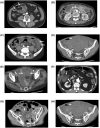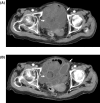Diagnosis of necrotic and non-necrotic small bowel strangulation: The importance of intestinal congestion
- PMID: 40385344
- PMCID: PMC12080211
- DOI: 10.1002/ags3.12894
Diagnosis of necrotic and non-necrotic small bowel strangulation: The importance of intestinal congestion
Abstract
Background: Despite the prevalence of laparoscopic techniques in abdominal surgeries today, bowel obstruction remains a potentially serious complication. Small bowel strangulation (SBS), in particular, is a critical condition that can lead to patient mortality. However, the prognosis for SBS is favorable if surgery is performed before the onset of necrosis. Non-necrotic SBS is a reversible condition in which blood flow can be restored by relieving the strangulation. The purpose of this study was to identify sensitive and specific contrast-enhanced computed tomography (CT) findings that are useful for diagnosis of both non-necrotic and necrotic SBS.
Methods: We included patients diagnosed with SBS and simple bowel obstruction (SBO) who underwent contrast-enhanced CT followed by surgery from 2006 to 2023. Two gastrointestinal surgeons independently assessed the images retrospectively.
Results: Eighty SBO and 141 SBS patients were included. Eighty-seven had non-necrotic SBS and 54 had necrotic SBS. Mesenteric edema was most frequently observed in both necrotic and non-necrotic SBS cases followed by abnormal bowel wall thickening. These two findings were observed significantly less frequently in SBO. Bowel hypo-enhancement is identified in only about half of the non-necrotic SBS cases, and it was detected at significantly higher rates in necrotic SBS compared to non-necrotic.
Conclusion: Mesenteric edema and abnormal bowel wall thickening are sensitive and specific signs of both non-necrotic and necrotic SBS. These two findings indicate mesenteric and bowel congestion. Detecting intestinal congestion can lead to an accurate diagnosis of SBS, particularly in case of non-necrotic SBS, where bowel hypo-enhancement may sometimes be absent.
Keywords: acute abdomen; small bowel obstruction; strangulation.
© 2024 The Author(s). Annals of Gastroenterological Surgery published by John Wiley & Sons Australia, Ltd on behalf of The Japanese Society of Gastroenterological Surgery.
Conflict of interest statement
Kay Uehara is an editorial member of Annals of Gastroenterological Surgery. The other authors have no potential conflicts of interest to declare.
Figures


Similar articles
-
Transmural Bowel Necrosis From Acute Mesenteric Ischemia and Strangulated Small-Bowel Obstruction: Distinctive CT Features.AJR Am J Roentgenol. 2020 Jan;214(1):90-95. doi: 10.2214/AJR.19.21693. Epub 2019 Sep 25. AJR Am J Roentgenol. 2020. PMID: 31553659
-
[Closed loop intestinal obstruction: role of computerized tomography].Radiol Med. 1999 Jan-Feb;97(1-2):54-9. Radiol Med. 1999. PMID: 10319100 Italian.
-
Assessment of Strangulation in Adhesive Small Bowel Obstruction on the Basis of Combined CT Findings: Implications for Clinical Care.Radiology. 2017 Dec;285(3):798-808. doi: 10.1148/radiol.2017162352. Epub 2017 Jul 31. Radiology. 2017. PMID: 28759326
-
CT findings of small bowel strangulation: the importance of contrast enhancement.Emerg Radiol. 2013 Jan;20(1):3-9. doi: 10.1007/s10140-012-1070-z. Epub 2012 Aug 22. Emerg Radiol. 2013. PMID: 22910982 Review.
-
Sensitivity and Specificity of CT and Its signs for Diagnosis of Strangulation in Patients with Acute Small Bowel Obstruction.JNMA J Nepal Med Assoc. 2014 Jan-Mar;52(193):735-44. JNMA J Nepal Med Assoc. 2014. PMID: 26905560 Review.
Cited by
-
A novel predictive scoring system for irreversible intestinal ischemia in patients with strangulated bowel obstruction.Surg Today. 2025 Aug 20. doi: 10.1007/s00595-025-03121-y. Online ahead of print. Surg Today. 2025. PMID: 40833480
-
Using computed tomography imaging for the quantitative assessment of bowel viability in incarcerated groin hernia.Surg Today. 2025 Jul 3. doi: 10.1007/s00595-025-03086-y. Online ahead of print. Surg Today. 2025. PMID: 40608066
References
-
- Millet I, Taourel P, Ruyer A, Molinari N. Value of CT findings to predict surgical ischemia in small bowel obstruction: a systematic review and meta‐analysis. Eur Radiol. 2015;25:1823–1835. - PubMed
-
- Hayakawa K, Tanikake M, Yoshida S, Yamamoto A, Yamamoto E, Morimoto T. CT findings of small bowel strangulation: the importance of contrast enhancement. Emerg Radiol. 2013;20:3–9. - PubMed
-
- Elsayes KM, Menias CO, Smullen TL, Platt JF. Closed‐loop small‐bowel obstruction: diagnostic patterns by multidetector computed tomography. J Comput Assist Tomogr. 2007;31:697–701. - PubMed
LinkOut - more resources
Full Text Sources

